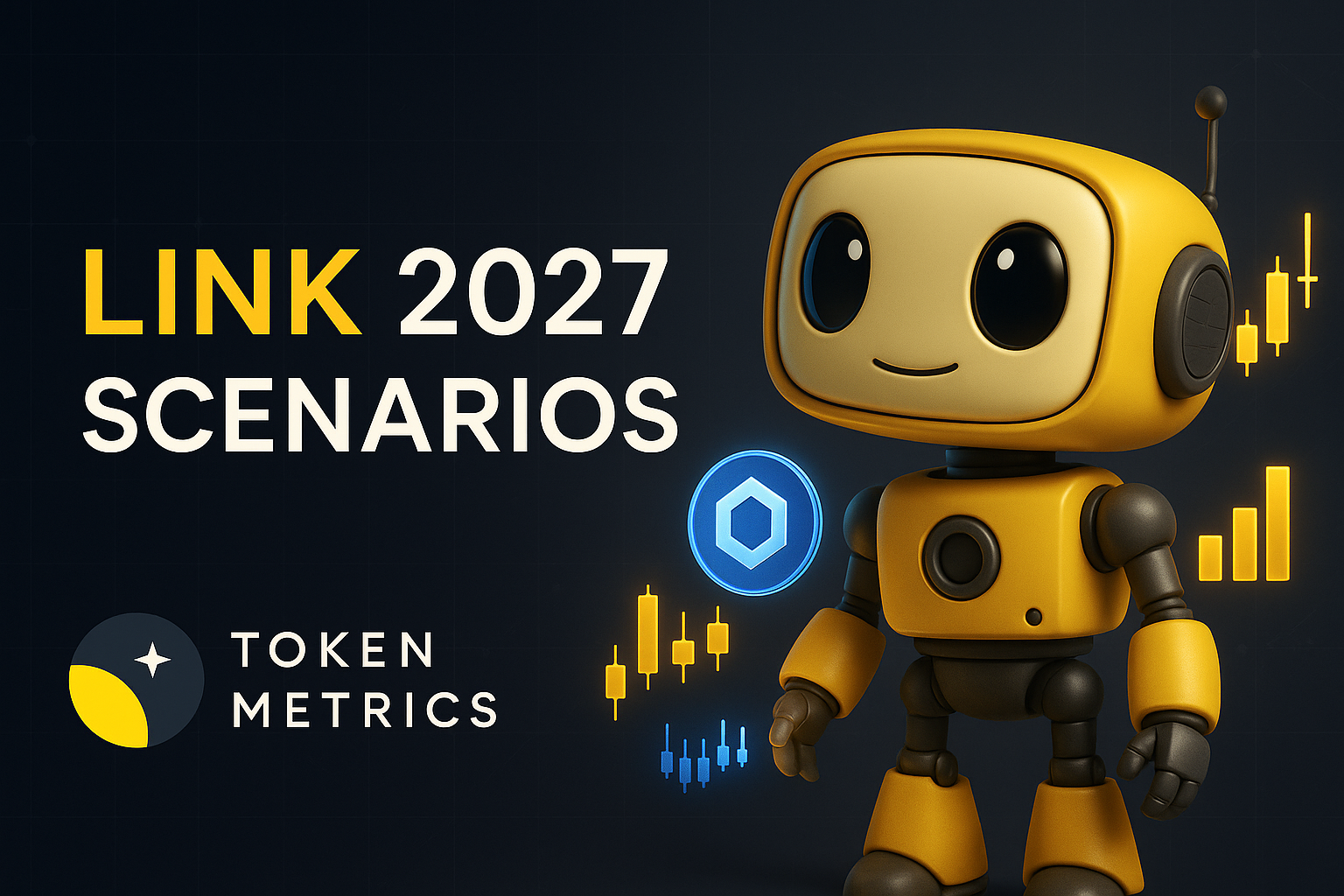Top Crypto Trading Platforms in 2025







%201.svg)
%201.svg)
Big news: We’re cranking up the heat on AI-driven crypto analytics with the launch of the Token Metrics API and our official SDK (Software Development Kit). This isn’t just an upgrade – it's a quantum leap, giving traders, hedge funds, developers, and institutions direct access to cutting-edge market intelligence, trading signals, and predictive analytics.
Crypto markets move fast, and having real-time, AI-powered insights can be the difference between catching the next big trend or getting left behind. Until now, traders and quants have been wrestling with scattered data, delayed reporting, and a lack of truly predictive analytics. Not anymore.
The Token Metrics API delivers 32+ high-performance endpoints packed with powerful AI-driven insights right into your lap, including:
Getting started with the Token Metrics API is simple:
At Token Metrics, we believe data should be decentralized, predictive, and actionable.
The Token Metrics API & SDK bring next-gen AI-powered crypto intelligence to anyone looking to trade smarter, build better, and stay ahead of the curve. With our official SDK, developers can plug these insights into their own trading bots, dashboards, and research tools – no need to reinvent the wheel.
%201.svg)
%201.svg)
Infrastructure protocols become more valuable as the crypto ecosystem scales and relies on robust middleware. Chainlink provides critical oracle infrastructure where proven utility and deep integrations drive long-term value over retail speculation. Increasing institutional adoption raises demand for professional-grade data delivery and security.
Token Metrics projections for LINK below span multiple total market cap scenarios from conservative to aggressive. Each tier assumes different levels of infrastructure demand as crypto evolves from speculative markets to institutional-grade systems. These bands frame LINK's potential outcomes into 2027.

Disclosure
Educational purposes only, not financial advice. Crypto is volatile, do your own research and manage risk.
How to read it: Each band blends cycle analogues and market-cap share math with TA guardrails. Base assumes steady adoption and neutral or positive macro. Moon layers in a liquidity boom. Bear assumes muted flows and tighter liquidity.
TM Agent baseline: Token Metrics lead metric for Chainlink, cashtag $LINK, is a TM Grade of 23.31%, which translates to a Sell, and the trading signal is bearish, indicating short-term downward momentum. This means Token Metrics currently does not endorse $LINK as a long-term buy at current conditions.
Live details: Chainlink Token Details
Affiliate Disclosure: We may earn a commission from qualifying purchases made via this link, at no extra cost to you.
Token Metrics scenarios span four market cap tiers, each representing different levels of crypto market maturity and liquidity:
8T: At an 8 trillion dollar total crypto market cap, LINK projects to $26.10 in bear conditions, $30.65 in the base case, and $35.20 in bullish scenarios.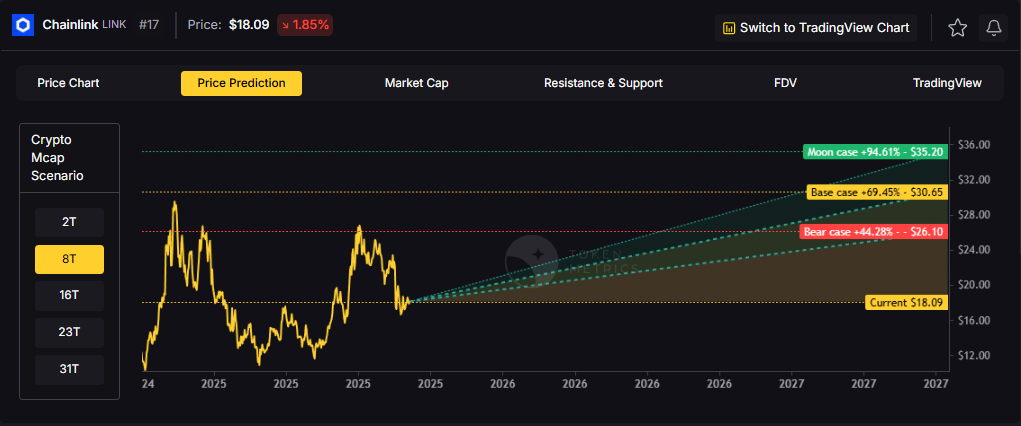
16T: Doubling the market to 16 trillion expands the range to $42.64 (bear), $56.29 (base), and $69.95 (moon).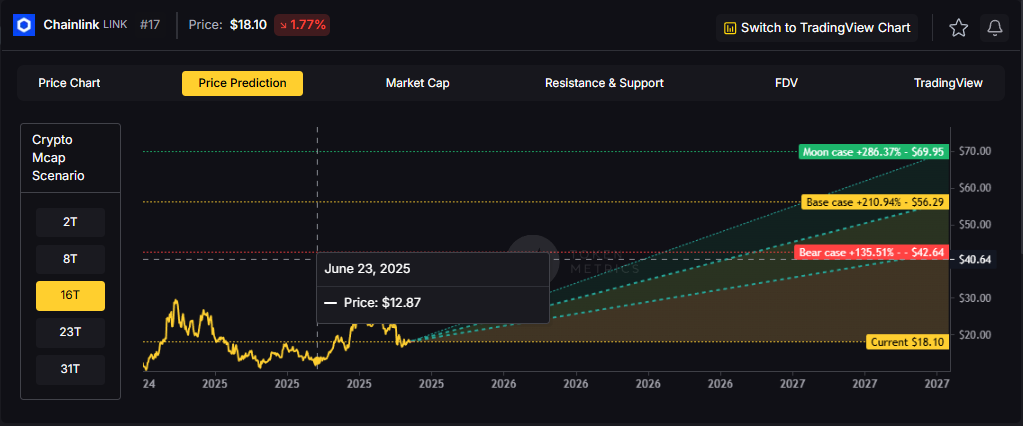
23T: At 23 trillion, the scenarios show $59.18, $81.94, and $104.70 respectively.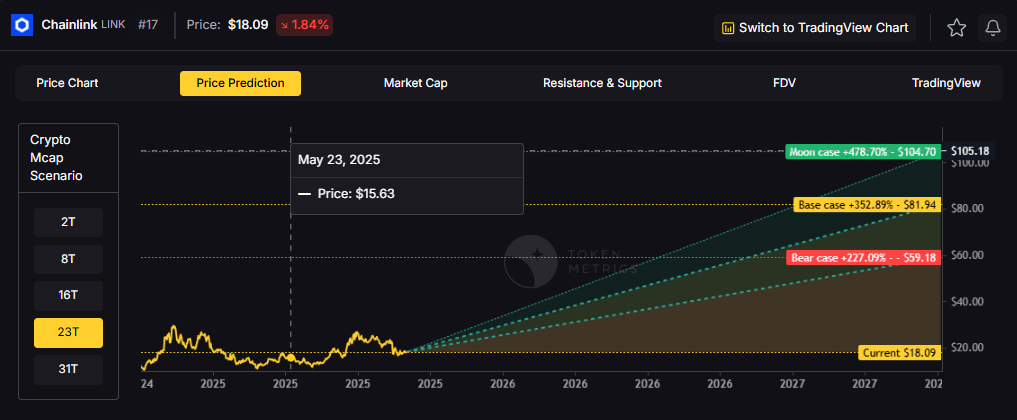
31T: In the maximum liquidity scenario of 31 trillion, LINK could reach $75.71 (bear), $107.58 (base), or $139.44 (moon).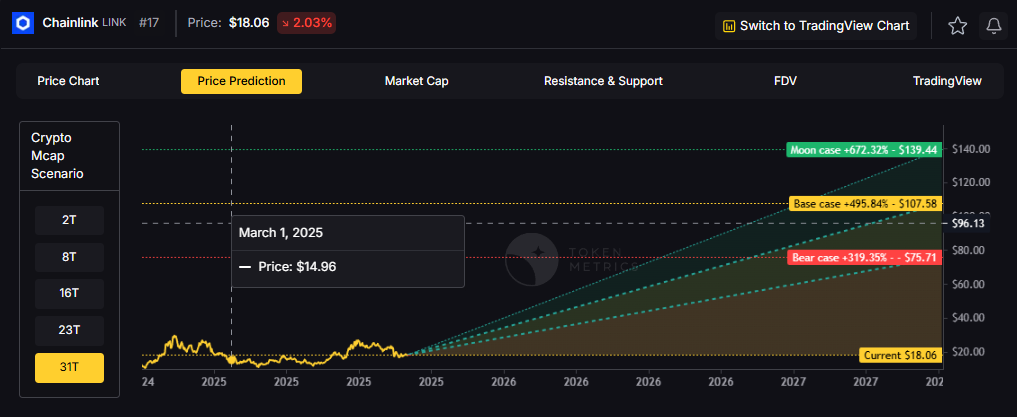
Chainlink represents one opportunity among hundreds in crypto markets. Token Metrics Indices bundle LINK with top one hundred assets for systematic exposure to the strongest projects. Single tokens face idiosyncratic risks that diversified baskets mitigate.
Historical index performance demonstrates the value of systematic diversification versus concentrated positions.
Chainlink is a decentralized oracle network that connects smart contracts to real-world data and systems. It enables secure retrieval and verification of off-chain information, supports computation, and integrates across multiple blockchains. As adoption grows, Chainlink serves as critical infrastructure for reliable data feeds and automation.
The LINK token is used to pay node operators and secure the network’s services. Common use cases include DeFi price feeds, insurance, and enterprise integrations, with CCIP extending cross-chain messaging and token transfers.
Vision: Chainlink aims to create a decentralized, secure, and reliable network for connecting smart contracts with real-world data and systems. Its vision is to become the standard for how blockchains interact with external environments, enabling trust-minimized automation across industries.
Problem: Smart contracts cannot natively access data outside their blockchain, limiting their functionality. Relying on centralized oracles introduces single points of failure and undermines the security and decentralization of blockchain applications. This creates a critical need for a trustless, tamper-proof way to bring real-world information onto blockchains.
Solution: Chainlink solves this by operating a decentralized network of node operators that fetch, aggregate, and deliver data from off-chain sources to smart contracts. It uses cryptographic proofs, reputation systems, and economic incentives to ensure data integrity. The network supports various data types and computation tasks, allowing developers to build complex, data-driven decentralized applications.
Market Analysis: Chainlink is a market leader in the oracle space and a key infrastructure component in the broader blockchain ecosystem, particularly within Ethereum and other smart contract platforms. It faces competition from emerging oracle networks like Band Protocol and API3, but maintains a strong first-mover advantage and widespread integration across DeFi, NFTs, and enterprise blockchain solutions. Adoption is driven by developer activity, partnerships with major blockchain projects, and demand for secure data feeds. Key risks include technological shifts, regulatory scrutiny on data providers, and execution challenges in scaling decentralized oracle networks. As smart contract usage grows, so does the potential for oracle services, positioning Chainlink at the center of a critical niche, though its success depends on maintaining security and decentralization over time.
Fundamental Grade: 74.58% (Community 81%, Tokenomics 100%, Exchange 100%, VC —, DeFi Scanner 17%).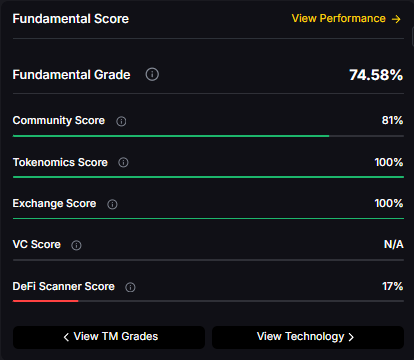
Technology Grade: 88.50% (Activity 81%, Repository 72%, Collaboration 100%, Security 86%, DeFi Scanner 17%).
Can LINK reach $100?
Yes. Based on the scenarios, LINK could reach $100+ in the 23T moon case. The 23T tier projects $104.70 in the moon case. Not financial advice.
What price could LINK reach in the moon case?
Moon case projections range from $35.20 at 8T to $139.44 at 31T. These scenarios assume maximum liquidity expansion and strong Chainlink adoption. Not financial advice.
Should I buy LINK now or wait?
Timing depends on risk tolerance and macro outlook. Current price of $18.09 sits below the 8T bear case in the scenarios. Dollar-cost averaging may reduce timing risk. Not financial advice.
Track live grades and signals: Token Details
Want exposure? Buy LINK on MEXC
Disclosure
Educational purposes only, not financial advice. Crypto is volatile, do your own research and manage risk.
Discover the full potential of your crypto research and portfolio management with Token Metrics. Our ratings combine AI-driven analytics, on-chain data, and decades of investing expertise—giving you the edge to navigate fast-changing markets. Try our platform to access scenario-based price targets, token grades, indices, and more for institutional and individual investors. Token Metrics is your research partner through every crypto market cycle.
%201.svg)
%201.svg)
The crypto market is tilting bullish into 2026 as liquidity, infrastructure, and participation improve across the board. Clearer rules and standards are reshaping the classic four-year cycle, flows can arrive earlier, and strength can persist longer than in prior expansions.
Institutional access is widening through ETFs and custody, while L2 scaling and real-world integrations help sustain on‑chain activity. This healthier backdrop frames our scenario work for HYPE. The ranges below reflect different total crypto market sizes and the share Hyperliquid could capture under each regime.
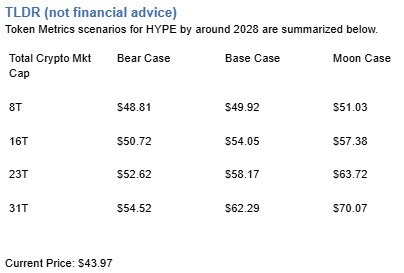
Disclosure
Educational purposes only, not financial advice. Crypto is volatile, do your own research and manage risk.
How to read it: Each band blends cycle analogues and market-cap share math with TA guardrails. Base assumes steady adoption and neutral or positive macro. Moon layers in a liquidity boom. Bear assumes muted flows and tighter liquidity.
TM Agent baseline: Token Metrics TM Grade is 73.9%, a Buy, and the trading signal is bearish, indicating short-term downward momentum. This means Token Metrics judges HYPE as fundamentally attractive over the long term, while near-term momentum is negative and may limit rallies.
Live details: Hyperliquid Token Details
Affiliate Disclosure: We may earn a commission from qualifying purchases made via this link, at no extra cost to you.
Scenario Analysis
Token Metrics scenarios span four market cap tiers, each representing different levels of crypto market maturity and liquidity:
8T: At an 8 trillion dollar total crypto market cap, HYPE projects to $48.81 in bear conditions, $49.92 in the base case, and $51.03 in bullish scenarios.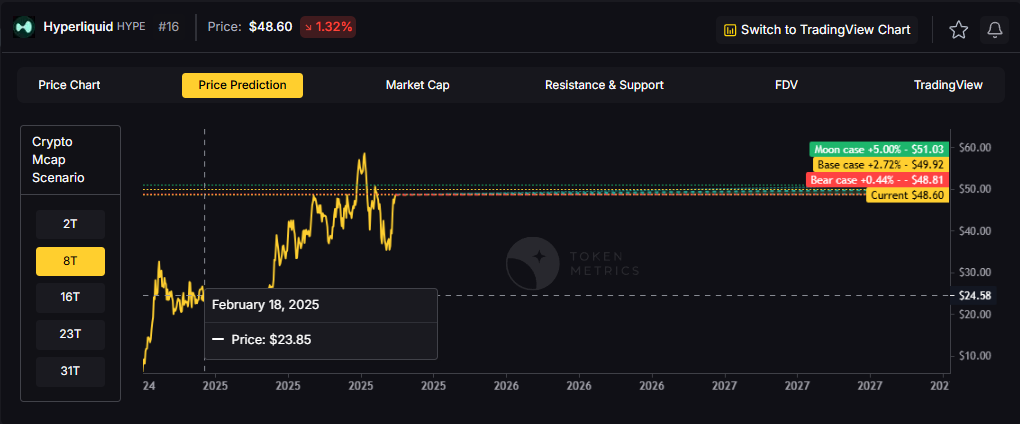
16T: Doubling the market to 16 trillion expands the range to $50.72 (bear), $54.05 (base), and $57.38 (moon).
23T: At 23 trillion, the scenarios show $52.62, $58.17, and $63.72 respectively.
31T: In the maximum liquidity scenario of 31 trillion, HYPE could reach $54.52 (bear), $62.29 (base), or $70.07 (moon).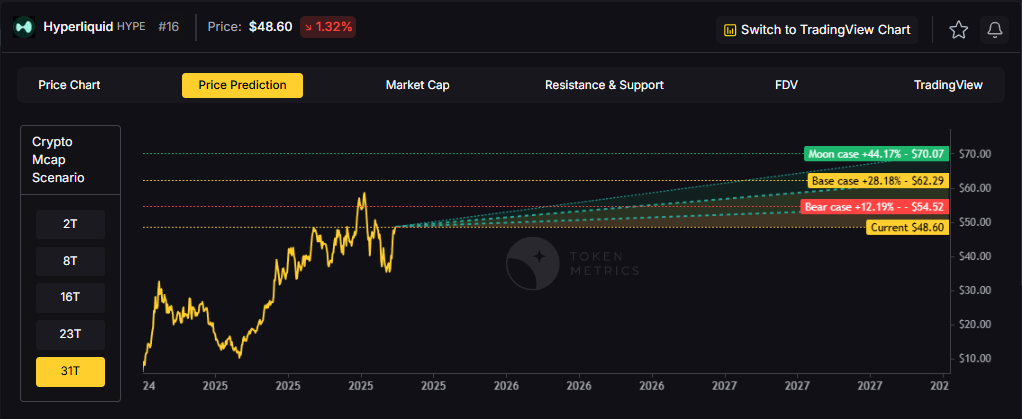
Each tier assumes progressively stronger market conditions, with the base case reflecting steady growth and the moon case requiring sustained bull market dynamics.
Diversification matters. HYPE is compelling, yet concentrated bets can be volatile. Token Metrics Indices hold HYPE alongside the top one hundred tokens for broad exposure to leaders and emerging winners.
Our backtests indicate that owning the full market with diversified indices has historically outperformed both the total market and Bitcoin in many regimes due to diversification and rotation.
Hyperliquid is a decentralized exchange focused on perpetual futures with a high-performance order book architecture. The project emphasizes low-latency trading, risk controls, and capital efficiency aimed at professional and retail derivatives traders. Its token, HYPE, is used for ecosystem incentives and governance-related utilities.
Can HYPE reach $60?
Yes, the 23T and 31T tiers imply ranges above $60 in the Base and Moon bands, though outcomes depend on liquidity and adoption. Not financial advice.
Is HYPE a good long-term investment?
Outcome depends on adoption, liquidity regime, competition, and supply dynamics. Diversify and size positions responsibly.
Disclosure
Educational purposes only, not financial advice. Crypto is volatile, do your own research and manage risk.
Token Metrics delivers AI-based crypto ratings, scenario projections, and portfolio tools so you can make smarter decisions. Discover real-time analytics on Token Metrics.
%201.svg)
%201.svg)
The Layer 1 competitive landscape is consolidating as markets recognize that specialization matters more than being a generic "Ethereum killer." Cardano positions itself in this multi-chain world with specific technical and ecosystem advantages. Infrastructure maturity around custody, bridges, and developer tools makes alternative L1s more accessible heading into 2026.
The scenario projections below map different market share outcomes for ADA across varying total crypto market sizes. Base cases assume Cardano maintains current ecosystem momentum, while moon scenarios factor in accelerated adoption and bear cases reflect increased competitive pressure.

Disclosure
Educational purposes only, not financial advice. Crypto is volatile, do your own research and manage risk.
How to read it: Each band blends cycle analogues and market-cap share math with TA guardrails. Base assumes steady adoption and neutral or positive macro. Moon layers in a liquidity boom. Bear assumes muted flows and tighter liquidity.
TM Agent baseline: Token Metrics lead metric for Cardano, cashtag $ADA, is a TM Grade of 29.72%, which translates to a Sell, and the trading signal is bearish, indicating short-term downward momentum. This combination means Token Metrics does not currently endorse $ADA as a long-term buy at current levels. A brief market context: Bitcoin's direction remains the dominant macro driver for smart contract platforms, so sustained upside for $ADA would require a broader crypto risk-on regime and improving fundamentals or developer activity for Cardano.
Live details: Cardano Token Details
Affiliate Disclosure: We may earn a commission from qualifying purchases made via this link, at no extra cost to you.
Token Metrics scenarios span four market cap tiers, each representing different levels of crypto market maturity and liquidity:




Each tier assumes progressively stronger market conditions, with the base case reflecting steady growth and the moon case requiring sustained bull market dynamics.
Cardano represents one opportunity among hundreds in crypto markets. Token Metrics Indices bundle ADA with top one hundred assets for systematic exposure to the strongest projects. Single tokens face idiosyncratic risks that diversified baskets mitigate.
Historical index performance demonstrates the value of systematic diversification versus concentrated positions.
Cardano is a blockchain platform designed to support secure, scalable, and sustainable decentralized applications and smart contracts. It is known for its research-driven development approach, emphasizing peer-reviewed academic research and formal verification methods to ensure reliability and security. As a proof-of-stake Layer 1 blockchain, Cardano aims to offer energy efficiency and long-term scalability, positioning itself as a competitor to platforms like Ethereum. Its native token, ADA, is used for transactions, staking, and governance. Adoption is driven by technological rigor and ecosystem growth, though progress has been criticized for being slow compared to more agile competitors. Risks include execution delays, competition, and market volatility.
Cardano’s vision is to create a decentralized platform that enables sustainable and inclusive economic systems through advanced cryptography and scientific methodology. It aims to bridge gaps between traditional financial systems and blockchain technology, promoting accessibility and security for users globally.
Token Metrics AI provides comprehensive context on Cardano's positioning and challenges.


Can ADA reach $4?
Based on the scenarios, ADA could reach $4 in the 31T moon case. The 31T tier projects $4.27 in the moon case. Not financial advice.
Can ADA 10x from current levels?
At current price of $0.65, a 10x would reach $6.50. This falls within none of the provided scenarios, which top out at $4.27 in the 31T moon case. Bear in mind that 10x returns require substantial market cap expansion. Not financial advice.
What price could ADA reach in the moon case?
Moon case projections range from $1.16 at 8T to $4.27 at 31T. These scenarios assume maximum liquidity expansion and strong Cardano adoption. Not financial advice.
Disclosure
Educational purposes only, not financial advice. Crypto is volatile, do your own research and manage risk.

%201.svg)
%201.svg)
Swapping cryptocurrency has become an essential part of the digital currencies market, allowing users to exchange one digital asset for another quickly and efficiently. Whether you want to swap bitcoin for altcoins or exchange other cryptocurrencies, understanding how to swap crypto efficiently with low fees and the best rates is crucial. By using a reliable crypto exchange, you can securely store and swap cryptocurrencies with confidence. Many users prefer to manage their assets through a self-custody wallet, which offers greater control and security. To complete a cryptocurrency swap, you must enter a receiving wallet address. To get started, it is important to choose a trustworthy cryptocurrency exchange that supports seamless crypto swaps and provides a smooth user experience.

Selecting the right crypto exchange is key to swapping cryptocurrency effectively. Begin by researching and comparing various crypto exchanges to find platforms that offer the best rates and low fees. A non-custodial platform is often preferred because it allows users to securely store and swap cryptocurrencies without relinquishing control of their digital assets. Security features should be a top priority—look for exchanges with strong encryption, two-factor authentication, and a responsive support team to assist you when needed. Additionally, you send the cryptocurrency you want to swap to a generated deposit address provided by the platform. Reviewing transaction history and user feedback can provide insights into the platform’s reliability and performance, helping you make an informed decision.
To swap crypto efficiently, consider using a decentralized exchange (DEX). Decentralized exchanges enable users to trade directly from their wallets, avoiding the high network fees often associated with centralized platforms. These exchanges leverage smart contracts to execute swaps securely and automatically, reducing the risk of errors or fraud. Users often receive tokens in their wallet after the exchange completes, which can take from a few minutes to several hours depending on network conditions. When swapping crypto, it’s important to select the best crypto pair or swap pairs that align with your trading goals, as this can maximize the value of your transaction. Always factor in gas fees and other costs associated with the swap to ensure the process remains cost-effective.

Non-custodial platforms have grown in popularity among crypto users who want full control over their digital assets. By using a self-custody wallet, you can securely store and swap cryptocurrencies without relying on third parties. This flexibility means you maintain control over your funds at all times, reducing exposure to hacks or mismanagement. Non-custodial swaps empower users to manage their assets directly, execute transactions quickly, and maintain privacy. Swapping crypto usually incurs a network fee, paid in the native currency of the blockchain used for the swap. Learning how to navigate these platforms is essential for anyone looking to swap crypto securely and efficiently.
For those new to the market, buying crypto is the first step before swapping. You can buy bitcoin or other cryptocurrencies using various payment methods such as bank transfers, credit cards, or digital payment services. Once you have acquired your digital assets, you can swap crypto immediately to take advantage of favorable market trends. However, the amount you can swap may be subject to platform limitations, such as minimum or maximum amounts. Using a reliable crypto exchange ensures you get the best exchange rate and pay minimal fees during both the purchase and swap processes. Always consider the exchange rate and associated fees to optimize your investment.
Bitcoin remains the most traded cryptocurrency, and swapping bitcoin for other cryptocurrencies is a common practice. Utilizing a decentralized exchange to swap bitcoin can help you benefit from low fees and the best rates available. Storing bitcoin in a self-custody wallet before swapping provides an added layer of security, ensuring your funds are safe throughout the transaction. Once a swap is confirmed, it may take time for the transaction to complete based on the blockchain used. Understanding how to swap bitcoin efficiently empowers users to diversify their portfolios and capitalize on market opportunities without unnecessary delays or costs.

Choosing the right swap pairs is fundamental to maximizing the value of your crypto swaps. Different crypto pairs offer varying exchange rates and liquidity, so comparing rates and fees across multiple crypto exchanges can help you find the most advantageous options. Reliable platforms often provide transparent pricing and low fees, enabling users to make swaps with confidence. Crypto swaps can involve fluctuating fees based on network traffic and volatility. Keeping an eye on market trends and exchange rates ensures you execute swaps at the most favorable times, enhancing your overall crypto trading strategy.
Securing the best rates when you swap cryptocurrency depends largely on the platform you use. By selecting a reputable crypto exchange, you can access competitive prices and benefit from low fees. Decentralized exchanges often provide an edge by minimizing network fees, making them an attractive option for cost-conscious users. Changelly, for instance, has industry-low fees of up to 0.25% on crypto exchanges. Comparing rates and fees across several exchanges before executing a swap is a smart practice that helps you get the most value from your digital assets.

Security is paramount when swapping crypto. Using a self-custody wallet allows you to securely store and swap cryptocurrencies without exposing your funds to third-party risks. Smart contracts enhance security by automating swap execution in a transparent and tamper-proof manner. When choosing a crypto exchange, pay close attention to its security features and the responsiveness of its support team. Learning how to securely swap crypto and manage your digital assets protects you from fraud and ensures peace of mind.
Accessing a worldwide crypto exchange opens the door to global markets, providing more swap pairs and competitive rates. These platforms typically offer low fees and robust security features, supported by dedicated teams that assist users around the clock. Using a worldwide exchange allows you to diversify your portfolio and take advantage of opportunities across different regions. Mastering how to use such exchanges can help you swap crypto efficiently and manage your assets with greater flexibility.
For beginners and experienced users alike, the easiest crypto exchange combines user-friendliness with powerful features. These platforms provide intuitive interfaces, clear instructions, and helpful tools that simplify the swapping process. Low fees and the best rates are often part of their offerings, making it easier for users to trade and swap crypto without hassle. Learning how to navigate the easiest crypto exchange can significantly enhance your crypto trading experience, allowing you to execute swaps quickly and cost-effectively.
Many users have questions about how to swap crypto and manage their digital assets effectively. Common inquiries include the benefits and risks of swapping, how to choose swap pairs, and how to handle fees and security. Understanding these aspects helps users make informed decisions and avoid common pitfalls. Accessing resources and support from reliable crypto exchanges further aids in efficient and cost-effective crypto swaps.
To swap crypto efficiently, it’s important to follow some key tips and tricks. Always prioritize security by using non-custodial wallets and reputable exchanges. Take advantage of market trends and choose swap pairs with favorable exchange rates. Managing gas fees and network fees carefully can save you money. Additionally, leveraging the flexibility and control offered by reliable platforms ensures a smooth swapping experience.
Avoiding common mistakes is crucial for a successful crypto swap. Neglecting security, ignoring fees, and rushing into swaps without research can lead to losses. Always maintain control of your assets by using self-custody wallets and avoid platforms with poor reputations. Utilize available support resources to navigate the swap process confidently and secure the best rates.

Staying informed about crypto swap market trends allows you to make smarter trading decisions. Market analysis helps you understand price movements, liquidity changes, and emerging swap pairs. By leveraging these insights, you can time your swaps to maximize returns and minimize costs. Reliable exchanges often provide tools and resources to keep users updated on the latest market developments.
The regulatory landscape for crypto swap is evolving rapidly. Staying compliant with relevant laws and regulations is essential for secure and legal transactions. Reliable crypto exchanges typically adhere to regulatory standards and provide users with guidance to ensure compliance. Keeping abreast of regulatory changes helps you avoid legal issues and maintain a secure trading environment.
The future of crypto swap looks promising, with ongoing innovations enhancing security, speed, and accessibility. Advances in smart contracts, non-custodial swaps, and decentralized exchanges are shaping the next generation of crypto trading platforms. Staying informed about these developments and using reliable exchanges prepares users to benefit from future trends. Embracing these innovations will help you stay ahead of the curve in the dynamic world of digital assets.
By understanding these key aspects of swapping cryptocurrency, you can navigate the market efficiently, securely, and cost-effectively. Whether you are swapping bitcoin, exchanging other cryptocurrencies, or exploring new digital assets, choosing the right platform and strategies will maximize your success in the evolving crypto landscape.

%201.svg)
%201.svg)
Cryptocurrency trading involves the exchange of one digital asset for another on a trading platform, a process made possible through the use of cryptocurrency trading pairs. These trading pairs are essential components of the cryptocurrency market, serving as the foundation for all trading activities. They allow traders to evaluate market trends and make informed decisions by comparing the relative value of the base currency against the quote currency. Understanding how crypto trading pairs work is vital not only for executing trades but also for effective portfolio diversification and navigating the complex market dynamics of the cryptocurrency market. With a wide range of different trading pairs available, traders are presented with diverse trading opportunities that reflect the unique characteristics and market conditions of various digital assets.

A trading pair consists of two different digital assets, such as BTC/ETH or ETH/BTC, enabling traders to exchange one cryptocurrency for another. In these pairs, the first currency listed is known as the base currency, which serves as the reference point for the trading pair. The second currency is called the quote currency, representing the currency used to price the base currency. For example, in the BTC/ETH pair, Bitcoin (BTC) is the base currency, and Ethereum (ETH) is the quote currency. Similarly, in the trading pair BTC/USD, Bitcoin is the base currency and USD is the quote currency. Trading pairs allow traders to compare costs between different cryptocurrencies by showing the exchange rate or comparative value of one crypto asset relative to another. This system also extends to fiat currency pairs, where digital assets are traded against traditional currencies like the US dollar, providing an essential link between the crypto market and the broader financial ecosystem.

Crypto trading pairs work by facilitating the exchange of one digital asset for another on a trading platform. The price of the trading pair is determined by market sentiment and current market conditions, reflecting the supply and demand dynamics between the two cryptocurrencies involved. Trading pairs serve as unique value equations between two parts, allowing traders to speculate on price movements between different cryptocurrencies, offering opportunities for profit as well as risk of loss. Different crypto exchanges offer a variety of trading pairs, and the availability of specific pairs can significantly affect liquidity and trading opportunities. Some pairs, like BTC/ETH or stablecoin pairs, often provide better liquidity, making it easier for traders to enter and exit positions. Understanding how trading pairs work is essential for developing a successful trading strategy and implementing effective risk management techniques in the fast-paced crypto market.
Analyzing trading pairs is a crucial step in cryptocurrency trading. It involves examining price charts, market movements, and trading volume to gain insights into market trends and make informed trading decisions. Technical analysis serves as an essential tool in this process, helping traders identify patterns, trends, and potential price movements within the crypto market. Additionally, incorporating risk management strategies is vital when analyzing trading pairs, as these strategies help mitigate potential losses and optimize gains. Understanding trading pairs is crucial for exploiting arbitrage opportunities, as traders can identify price discrepancies across different markets. By carefully studying trading pairs, traders can better understand market dynamics and improve their ability to make trading decisions that align with their goals and risk tolerance.

Market trends play a pivotal role in cryptocurrency trading, and trading pairs provide valuable information about market sentiment and price movements. Understanding these trends requires analyzing various market data, including price charts and trading volumes, to detect patterns that indicate whether the market is bullish, bearish, or ranging. Illiquidity in the market can create opportunities for arbitrage, as price discrepancies between trading pairs may arise. Trading pairs enable traders to identify these trends by comparing the performance of two cryptocurrencies relative to each other, offering insights into market movements and potential future developments. By staying informed about market trends, traders can tailor their trading strategies to current market conditions, increasing their chances of success and better managing the risks associated with volatile crypto markets.
A well-defined trading strategy is essential for navigating the complexities of cryptocurrency trading. Such a strategy outlines a plan for buying and selling digital assets, leveraging trading pairs to facilitate transactions and manage risk effectively. Trading strategies often incorporate technical analysis, market trend evaluation, and risk management principles to help traders meet their specific trading goals. Using stop-loss orders and maintaining favorable risk-reward ratios enhances trading strategies, providing a structured approach to managing trades. Since different trading pairs exhibit unique market behaviors and liquidity levels, traders must adapt their strategies to the characteristics of each pair and the prevailing market conditions. By developing and adhering to a robust trading strategy, traders can enhance their ability to capitalize on trading opportunities while minimizing potential losses in the highly dynamic crypto economy.

Risk management is a fundamental aspect of successful cryptocurrency trading, and trading pairs provide various avenues for managing risk through diversification and hedging. By spreading investments across different crypto assets and trading pairs, traders can reduce their exposure to adverse market movements affecting a single digital asset. Risk management often requires a balanced approach, combining strategies such as setting stop-loss orders, controlling position sizes, and using stablecoin pairs for stability to help mitigate potential losses and protect capital. Effective risk management enables traders to preserve their portfolios and maintain a balanced approach to trading, aligning with their risk tolerance and long-term trading goals within the crypto market.
In conclusion, understanding cryptocurrency trading pairs is indispensable for success in the crypto market. Trading pairs offer a framework for buying and selling digital assets, providing insights into market trends, facilitating risk management, and enabling the development of effective trading strategies. The most widely traded digital asset that is integrated into the cryptocurrency market is BTC, which often serves as a base currency in many trading pairs. Each trading pair presents unique opportunities and challenges, requiring traders to cultivate a deep understanding of market dynamics and the specific characteristics of different digital assets. By analyzing trading pairs, staying informed about market sentiment and trends, and implementing sound trading and risk management strategies, traders can enhance their ability to make informed decisions and achieve their trading objectives. Ultimately, cryptocurrency trading pairs are essential tools that empower traders to navigate the evolving digital asset landscape with confidence and precision.

%201.svg)
%201.svg)
Introduction
With Bitcoin in price discovery and meme coins dominating short-term trends, crypto markets in 2025 are in a new phase of the cycle. At Token Metrics, we’ve been tracking smart money, emerging tokens, and high-conviction sectors like DeFi, AI, and meme assets. This post breaks down what we’re seeing—and how traders are adapting.
Bitcoin remains strong, with ETH and SOL following closely. Our models suggest:


Despite regulatory noise, crypto’s fundamentals—liquidity, user growth, and capital rotation—remain bullish.
Meme coins are leading short-term market action. Among the top gainers:
While volatility is high, top-performing meme coins on new chains often yield strong short-term returns—especially when backed by rising ecosystems like SUI.
We’ve doubled down on using platforms like Nansen to follow profitable wallet cohorts. These tools help us identify early-stage tokens with smart money inflows. Key indicators:
We also track wallet activity over time to confirm whether top-performing wallets are accumulating or exiting positions.
While meme coins grab headlines, we’re also analyzing sectors with long-term viability:
We balance high-risk meme trades with deep fundamental research into projects gaining traction on-chain and in product development.
The Hedera (HBAR) ecosystem recently saw a 5x spike in DEX volume. Tokens like:
are trending upward. While TVL remains low, increased volume may spark price momentum.
We’re not rotating capital aggressively here yet, but we’re watching closely for sustained on-chain activity.
Altcoin rotation often follows BTC consolidation. With BTC and ETH leading the charge, we expect:
Internal price models and momentum indicators support further upside, assuming macro remains stable and regulatory conditions don’t sharply deteriorate.
The current cycle rewards those who combine quantitative analysis, on-chain tracking, and strong narrative awareness. Whether trading LoFi for a quick flip or accumulating tokens like Fractal AI or USUAL for a thesis-driven hold, the key is staying ahead of trends without abandoning discipline.

%201.svg)
%201.svg)
The term “moonshot” is everywhere in the crypto world—but what does it really mean? In 2025, as the search for the next 100x token intensifies, understanding the concept of a crypto moonshot is more important than ever. Moonshots offer massive upside potential, but they also come with high risk. So how do you find them, and more importantly, how do you separate hype from real opportunity?
In this guide, we’ll break down what a moonshot is, why it matters, how to identify one, and how tools like Token Metrics are helping investors discover the next big thing in crypto—before it takes off.
In crypto, a moonshot refers to a low-cap, high-potential cryptocurrency that could deliver outsized returns, typically 10x, 50x, or even 100x your initial investment. The term comes from the idea that a token is going “to the moon”—crypto slang for an explosive price increase.
Unlike established cryptocurrencies like Bitcoin and Ethereum, moonshots are usually early-stage projects with small market caps, limited trading volume, and a high level of speculation. These tokens often sit under the radar, only gaining traction once a specific narrative, innovation, or market trend brings them into the spotlight.

While no one can guarantee a moonshot, successful ones often share several key traits:
Most moonshots start with a market cap under $50 million, sometimes even under $10 million. This gives them room to grow exponentially as adoption increases.
Moonshots usually align with emerging crypto narratives, such as:

They bring new ideas or solve real problems, giving them the potential to disrupt existing models.
Even if small, moonshots typically have loyal, vocal communities that drive awareness and support adoption.
Tokens that play a critical role in a product’s functionality (staking, access, governance) are more likely to gain value as adoption grows.
Getting listed on a major CEX (centralized exchange) or DEX (decentralized exchange) often serves as a catalyst for price surges.
While the upside is massive, moonshots come with serious risks:
Risk management is essential. Only allocate a small portion of your portfolio to moonshots and always do your own research.
Finding true moonshots is part art, part science. Here are practical steps to help spot them:
Token Metrics, the leading AI-powered crypto research platform, features a dedicated Moonshots tab that helps users discover early-stage altcoins with massive potential.
Token Metrics uses AI models to:
Pay attention to sectors gaining momentum—AI, DePIN, L2s, gaming, and RWA are hot in 2025. Moonshots often emerge at the intersection of narrative and innovation.
Many early-stage gems are discussed by small communities, KOLs (key opinion leaders), and early investors before any mainstream media coverage.

A great idea can’t succeed with poor tokenomics. Look for:
Platforms like Uniswap, Camelot, or Base-native DEXs are where most moonshots launch first. Analyze:
Token Metrics is the ultimate tool for discovering and validating moonshot opportunities. Here’s how:
Get real-time Investor Grade and Trader Grade scores, generated by AI models trained on historical altcoin performance.
Get alerts when a token shows strong upside or downside momentum based on quantitative signals.
A curated feed of low-cap, high-potential tokens filtered by market cap, sector, risk level, and on-chain traction.
Use simulation tools to see how a moonshot would have performed in different market conditions, helping you gauge timing and position sizing.
👉 Try Token Metrics with a 7-day free trial and start exploring moonshots with data, not just hype.
In previous years, several tokens started as moonshots and delivered massive gains:
In 2025, emerging moonshots include AI-powered tokens like $TMAI (Token Metrics AI)—positioned at the forefront of AI + crypto convergence.
Moonshot investing isn’t about certainty—it’s about asymmetrical bets with defined downside and massive upside.
Moonshots are the heartbeat of crypto innovation. They represent the bold, risky, and visionary projects that could reshape entire industries—or fade into obscurity.
In 2025, the opportunity to find the next Solana, MATIC, or PEPE still exists—but success comes from informed decisions, not hype-driven FOMO. That’s why platforms like Token Metrics are critical. With AI-powered research, curated moonshot lists, and real-time trading signals, Token Metrics helps you spot the gems before they moon.
So, what’s your next moonshot?
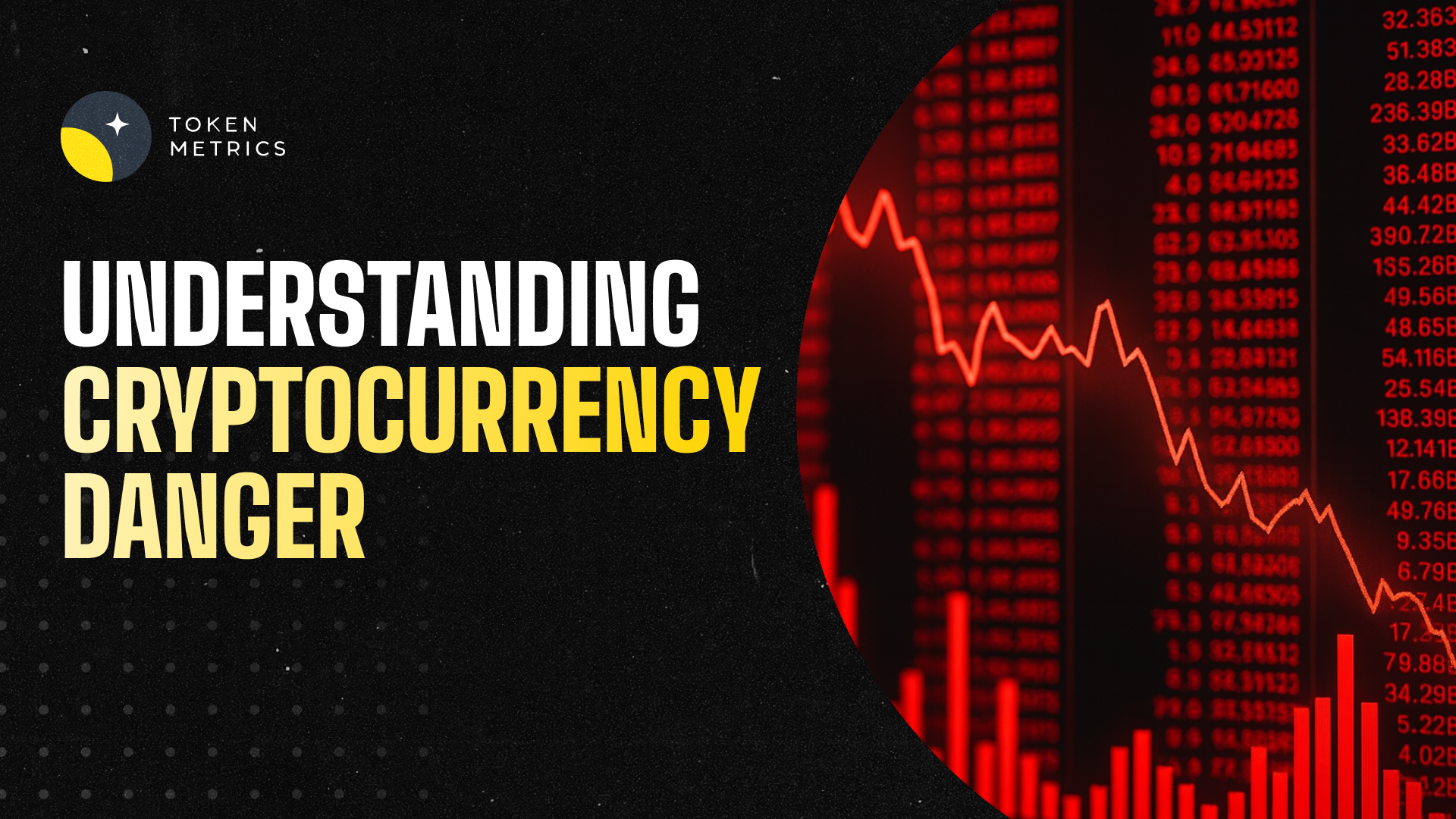
%201.svg)
%201.svg)
Cryptocurrency is a form of digital currency secured by cryptography, making it nearly impossible to counterfeit or double-spend. As a type of crypto asset, cryptocurrencies operate on decentralized networks powered by blockchain technology—a distributed public ledger maintained by multiple computers worldwide. This decentralized nature sets cryptocurrencies apart from traditional finance systems, which rely heavily on centralized financial institutions and central banks.
Most cryptocurrencies are not issued or regulated by any central authority, which makes them resistant to government interference or manipulation. While this independence offers certain freedoms, it also means that cryptocurrency investments carry substantial risk. The underlying cryptography and blockchain technology are generally secure, but their complexity can be challenging for new users to navigate. Additionally, the market value of cryptocurrencies is often affected by media hype and investor opinion, further contributing to their volatility. Understanding cryptocurrency danger involves exploring both the innovative technology behind it and the volatile market dynamics that influence its value.

Cryptocurrency exchanges play a crucial role as crypto asset service providers, allowing investors to buy and sell cryptocurrencies like Bitcoin and other cryptocurrencies at market prices. These exchanges function similarly to stock markets but operate 24/7, reflecting the highly volatile nature of the crypto market. However, many cryptocurrency exchanges lack a high level of governmental oversight or auditability compared to traditional banks, which can expose users to additional risks.
Once purchased, cryptocurrencies must be stored securely, either in digital wallets controlled by the user or through third-party services such as Coinbase, which assist with storing crypto assets safely. Some brokerage platforms, like Robinhood, provide access to cryptocurrency investments but may impose restrictions on withdrawals, limiting how investors can transfer or sell cryptocurrencies. This highlights the importance of understanding the terms and risks associated with each platform.
For those seeking exposure to the crypto asset class without directly holding digital wallets, crypto ETFs offer a more traditional investment vehicle. These funds track the market value of cryptocurrencies and can be bought and sold through conventional brokerage accounts, bridging the gap between digital assets and traditional finance.
One of the most significant cryptocurrency dangers lies in cybersecurity risks. Despite the security of blockchain technology, crypto investments are vulnerable to scams, hacks, software bugs, and the highly volatile price swings inherent in the market. The private key—a unique cryptographic code—is the sole access point to an investor’s digital wallet and cryptocurrency holdings. Losing this private key means losing access to the entire investment permanently, with no recourse. If a private key is stolen, there is no way to retrieve it, similar to having a credit card with no authentication check.
Technical challenges and market speculation add layers of risk that investors must carefully consider. Hackers frequently target digital wallets and cryptocurrency exchanges, attempting to steal digital assets. Numerous exchanges have suffered massive security breaches, leading to substantial losses for users. To mitigate these risks, many investors use offline hardware wallets or cold storage solutions, which keep private keys disconnected from the internet connection and significantly reduce the chances of theft.
Cryptocurrency investments are highly speculative and carry substantial risk, making them unsuitable for risk-averse investors. The market’s high price volatility can lead to rapid gains but also significant losses, and investors should only commit funds they can afford to lose. Cryptocurrencies can potentially yield high returns, attracting speculative investors. Unlike traditional finance, where financial institutions and regulatory bodies provide certain protections, cryptocurrency markets operate with limited oversight, increasing the potential for market manipulation and fraud.

Understanding one’s personal risk tolerance is crucial before deciding to invest in cryptocurrencies. The lack of regulatory control means that how funds are used or managed may be opaque, and the risk of losing money is real and significant. Investors should approach cryptocurrency investments with caution and seek advice from qualified investment advisors to navigate these complexities.
Despite the risks, cryptocurrencies offer unique advantages. By removing reliance on centralized intermediaries such as banks or credit card companies, cryptocurrencies reduce systemic financial risks and enable more direct, peer-to-peer transactions. Transfers between parties are secured through public and private key cryptography and validated by consensus mechanisms like proof of work or proof of stake, which underpin blockchain technology.
Crypto transfers can often be faster than traditional money transfers, especially in cross-border remittances where converting fiat currency typically involves multiple intermediaries. Decentralized finance innovations like flash loans demonstrate how cryptocurrency transactions can occur almost instantaneously, providing new opportunities for investment and trading.

However, cryptocurrencies also pose significant risks and challenges. While transactions are pseudonymous, digital trails remain traceable by law enforcement agencies such as the Federal Bureau of Investigation (FBI). Cryptocurrencies have been exploited for illicit activities including money laundering, dark web transactions, and ransomware payments. China has banned cryptocurrency exchanges, transactions, and mining, although it has developed a Central Bank Digital Currency (CBDC).
The concentration of wealth in the crypto space is increasing, with large companies and investment funds accumulating substantial holdings. Additionally, cryptocurrency mining demands significant energy consumption, often concentrating mining power among a few large firms with vast resources.
Off-chain security issues, such as vulnerabilities in third-party platforms, and the inherent price volatility continue to challenge the practical implementation of cryptocurrencies. The ideal of a fully decentralized system is often compromised by market manipulation and fraud, underscoring the cryptocurrency danger investors face.
Unlike fiat currency, which is government-issued legal tender, cryptocurrencies lack official issuance and their legal status varies widely across jurisdictions. In the United States, the Internal Revenue Service (IRS) treats cryptocurrencies as financial assets or property for tax purposes, requiring capital gains taxes on sales or trades.
U.S. courts have classified cryptocurrencies as securities for institutional buyers but not for retail investors trading on exchanges, reflecting the complex regulatory environment. In July 2023, U.S. courts ruled that cryptocurrencies are considered securities when purchased by institutional buyers but not by retail investors on exchanges. Similarly, cryptocurrency regulations in Asia differ significantly by country, demonstrating the global uncertainty surrounding digital assets.
Investors must stay informed about evolving legal frameworks to understand the implications of investing in cryptocurrencies and ensure compliance with tax and regulatory requirements.
The irreversible nature of cryptocurrency transactions and limited regulatory oversight make the space ripe for scams. Fraudsters often use fake endorsements, pressure tactics, and misleading schemes to steal money from unsuspecting investors. For example, some have lost substantial sums—like Rhett, who lost $97,000 to a fraudulent Bitcoin trading scheme.
To avoid falling victim to scams, investors should exercise caution, conduct thorough research, and verify the legitimacy of any investment opportunity. Consulting with reputable investment advisors and relying on trusted sources can help mitigate the risk of fraud and ensure safer participation in the crypto market.
Despite the inherent risks, many individuals are drawn to cryptocurrency for its potential gains and innovative technology. To protect digital currency assets, users must adopt proactive security measures. Understanding cybersecurity risks is essential to safeguarding crypto investments from hackers and bad actors.
Best practices include using hardware wallets like Ledger or Trezor, which provide enhanced security by keeping private keys offline. Investors should create duplicate hardware wallets and store backups in secure locations to prevent permanent loss of access. Staying vigilant against phishing attacks and avoiding sharing private keys or sensitive information is critical for maintaining control over digital assets.

Cryptocurrencies remain a highly speculative and risky asset class characterized by substantial price volatility and cybersecurity dangers. Investment advisors often recommend treating crypto investments as trading instruments rather than long-term holdings due to their unpredictable nature.
Cryptocurrency products carry risks including illiquidity and the potential for total loss of the entire investment. Investors should only allocate funds they can afford to lose and fully understand the technical complexities and market dynamics before engaging in cryptocurrency trading.
By staying informed, exercising caution, and following best security practices, investors can navigate the cryptocurrency landscape more safely. However, the cryptocurrency danger remains real, and careful consideration is essential before investing in this rapidly evolving digital asset space. Understanding the security and risks related to cryptocurrency requires a much higher level of engagement than traditional investments.

%201.svg)
%201.svg)
Understanding the cryptocurrency market cap is fundamental for anyone interested in investing or trading digital currencies. Market capitalization, often referred to as market cap, is a key metric that reflects the total value of a cryptocurrency in the market. Cryptocurrency market capitalization represents the total value of all coins that have been mined for a specific cryptocurrency or all cryptocurrencies combined. This article will explore what cryptocurrency market cap means, how it is calculated, and why it matters for investors navigating the dynamic crypto market.
Market capitalization represents the total value of a cryptocurrency's circulating coins in the market. It is a crucial metric used by investors and professionals to gauge the relative size and importance of a digital currency within the crypto ecosystem. Understanding market cap is essential for making informed investment decisions, as it provides a snapshot of a cryptocurrency’s size, popularity, and growth potential.
The market cap of a cryptocurrency is calculated by multiplying its current price by the number of coins in circulation. This simple formula offers insight into the cryptocurrency’s total value and helps investors compare different crypto assets effectively. By knowing the market cap, investors can better understand a cryptocurrency’s position in the market and assess its potential for future growth.
To fully grasp the concept of crypto market cap, it is important to understand the role of circulating supply. The circulating supply refers to the number of coins currently available and actively traded in the market. It is this supply that determines the crypto market cap when multiplied by the cryptocurrency’s current price.
Circulating supply is distinct from total supply, which includes all coins that have been created, including those not yet available for trading or locked in reserves. For example, some projects may have a large total supply but a smaller circulating supply due to tokens held by the development team or locked in smart contracts. Recognizing the difference between circulating supply and total supply is vital when evaluating a cryptocurrency’s market capitalization and its potential impact on price and growth.
Market cap is calculated by multiplying the current price of a cryptocurrency by its circulating supply, providing a real-time measure of the asset's total value in dollars or other fiat currencies. This calculation is dynamic, as both price and circulating supply can fluctuate, causing the market cap to change rapidly.
This metric is important because it helps investors assess the size and value of a cryptocurrency relative to others in the crypto market. A higher market cap often indicates a more established and widely adopted cryptocurrency, such as Bitcoin or Ethereum, which tend to have greater network security and liquidity. Conversely, a low market cap may signal a newer or more speculative digital asset, often associated with higher risk and volatility.
Understanding market cap allows investors to make informed choices by comparing the total value of different cryptocurrencies and evaluating their potential for growth or decline.
Market capitalization plays a significant role in shaping investment strategies within the crypto market. It influences the level of risk investors are willing to take and the potential returns they might expect. Cryptocurrencies are categorized into three market cap sizes: large-cap (over $10 billion), mid-cap ($1 billion to $10 billion), and small-cap (under $1 billion). Large cap cryptocurrencies, typically those with a market cap exceeding $10 billion, are generally less volatile and more stable. These assets are favored by conservative investors who prioritize security and steady growth.
On the other hand, mid cap and small cap cryptocurrencies often present higher growth potential but come with increased risk and price volatility. Small cap cryptocurrencies may be more susceptible to market fluctuations and liquidity challenges but can offer substantial returns if their underlying projects succeed.
Staying informed about market trends and understanding how market cap affects demand, liquidity, and price movements are essential for developing effective investment strategies. Investors who respond appropriately to these factors are better positioned to capitalize on opportunities and mitigate risks.
A liquid market is characterized by the ability to quickly buy or sell assets without causing significant price changes. In the crypto market, liquidity is a critical factor affecting volatility and trading volume. High liquidity means that there is a large number of buyers and sellers, facilitating smooth transactions and reducing price manipulation risks.
Cryptocurrencies with a high market cap tend to have more liquid markets due to their popularity and widespread adoption. This liquidity attracts institutional investors and traders who require the ability to enter and exit positions efficiently. Conversely, small cap cryptocurrencies may suffer from low liquidity, leading to higher volatility and wider bid-ask spreads.
A liquid market with high trading volume provides better price stability and more trading opportunities, making it more attractive for both short-term traders and long-term investors.

The crypto market ecosystem is a complex and evolving environment influenced by various factors beyond market cap. Blockchain technology underpins all cryptocurrencies, providing the decentralized infrastructure that ensures transparency and security. Network security, driven by consensus mechanisms and the number of active nodes, plays a crucial role in maintaining trust and stability in the market.
Institutional investors have increasingly entered the crypto market, bringing greater capital, legitimacy, and scrutiny. Their participation often affects market trends and can lead to increased liquidity and reduced volatility in large cap cryptocurrencies.
Understanding this ecosystem and the interplay of technology, investor behavior, and market dynamics is essential for anyone looking to navigate the crypto market successfully. The market is constantly responding to new technologies, regulatory developments, and shifts in investor sentiment.

Large cap cryptocurrencies, such as Bitcoin and Ethereum, dominate the crypto market with market caps exceeding $10 billion. These digital assets are widely regarded as more stable and less volatile compared to smaller cryptocurrencies. Their established track records and strong network security make them attractive safe havens during periods of market uncertainty.
Large cap cryptocurrencies benefit from high liquidity and trading volume, which contribute to better price stability and ease of trading. However, because of their already substantial market capitalization, these assets may experience slower price growth compared to mid or small cap cryptocurrencies.
Investors often include large cap cryptocurrencies in their portfolios to provide balance and reduce overall risk.

While large cap cryptocurrencies offer stability, mid cap and small cap cryptocurrencies often present greater growth potential. These smaller crypto assets may be in earlier stages of development, with innovative projects and technologies that can lead to significant price appreciation.
Analyzing growth potential involves examining a cryptocurrency’s market cap, trading volume, underlying blockchain technology, and the strength of its project or business model. Investors also consider factors such as tokenomics, total supply, and network security to assess long-term viability.
However, higher growth potential comes with increased risk, including higher volatility and liquidity challenges. Investors must carefully weigh these factors and conduct thorough research before committing to investments in smaller cap cryptocurrencies.
Crafting effective investment strategies in the crypto market requires a comprehensive understanding of market trends, risk management, and portfolio diversification. Investors should clearly define their investment goals and risk tolerance before entering the market.
Market capitalization is a critical consideration in strategy development, as it affects liquidity, volatility, and potential returns. Diversifying investments across large cap, mid cap, and small cap cryptocurrencies can help balance risk while capturing growth opportunities.
Staying informed about the latest market trends, technological advancements, and regulatory changes is essential. Investors should be prepared to adapt their strategies as the crypto market evolves, responding to shifts in demand, supply, and broader economic factors.
In conclusion, understanding what cryptocurrency market cap is and how it influences the crypto market is vital for making informed investment decisions. By considering market cap alongside other metrics such as circulating supply, trading volume, and network security, investors can navigate the complex world of digital assets with greater confidence and success.

%201.svg)
%201.svg)
The crypto market moves fast, and staying ahead requires more than just watching charts — it takes actionable data, delivered in real‑time. That’s why we’re excited to announce a major upgrade for developers, traders, and analysts: the Moonshots feature is now live as a Token Metrics API endpoint.
This new endpoint brings the same powerful insights from our Premium Moonshots dashboard directly into your apps, dashboards, and trading systems — programmatically. Whether you’re building a crypto trading bot, creating dynamic watchlists, or backtesting new strategies, the Moonshots API gives you everything you need to make smarter, faster decisions.
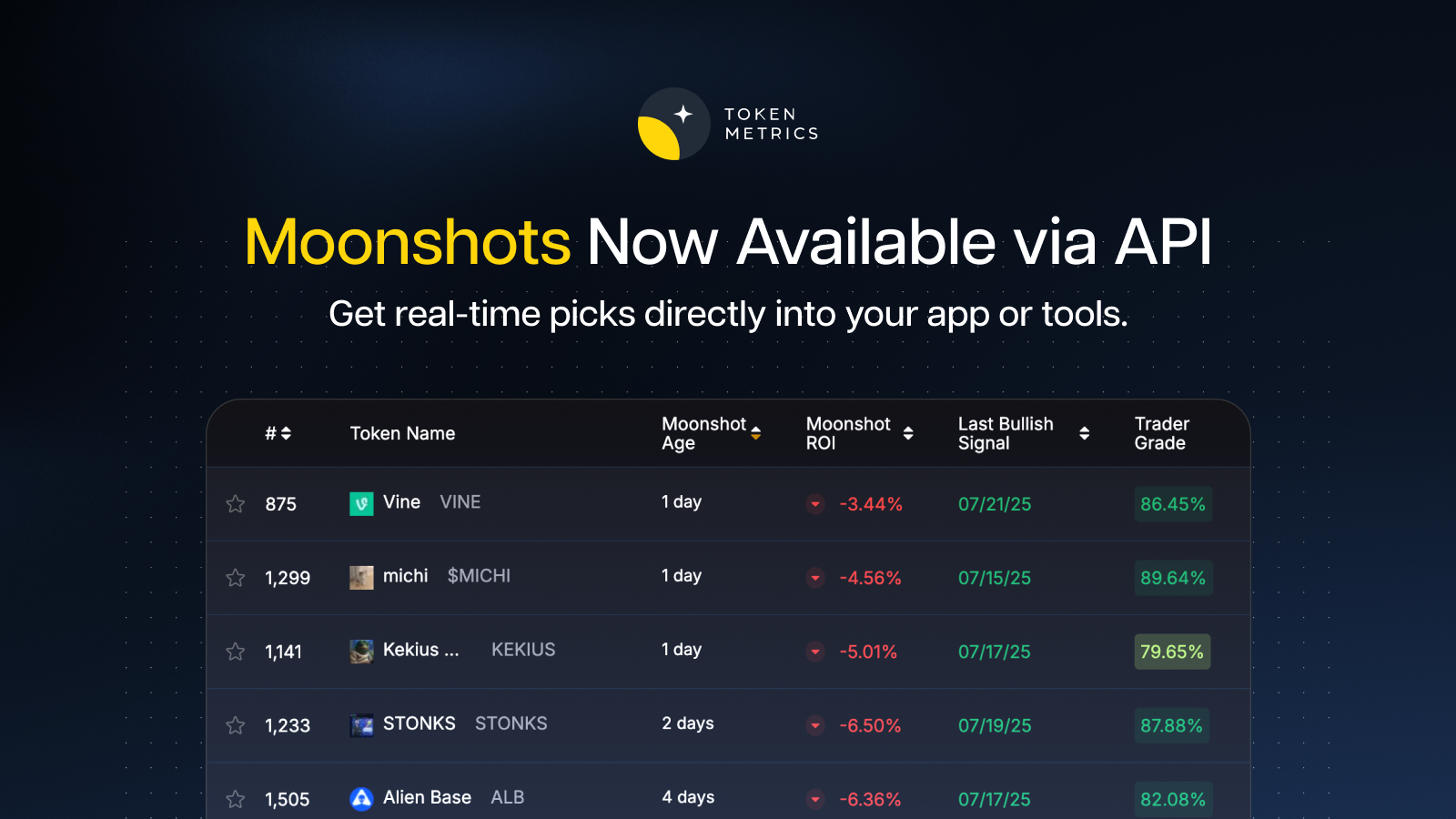
In crypto, “moonshots” are low‑cap tokens with high upside potential — the kind of high‑risk, high‑reward plays that can deliver outsized returns when identified early. At Token Metrics, our Moonshots aren’t just random picks.
They are:
Since launch, Moonshots have surfaced 43 tokens with a 65 % win rate across trades. The max single‑token return so far? 68 % — and counting.
For developers, this is no longer just data you view in our dashboard. It’s now available via API, ready to integrate into your workflows.

1. Programmatic Access to High‑Potential Trades
Get direct access to live Moonshot signals without needing to log into the platform. Perfect for apps, analytics dashboards, or automated trading systems.
2. Build Smarter Watchlists
Automatically populate your app or dashboard with AI‑curated, high‑potential tokens.
3. Trigger Bots in Real Time
Integrate the Moonshots feed into your trading bots so they can act instantly when a new token surfaces.
When you call the /v2/moonshot-tokens endpoint, you’ll get:
Want to see how these signals have performed over time? Use /v2/moonshots-tokens with type=past param for detailed past performance data.
The Moonshots API is designed for:
Your code could be live in minutes.
Give your users instant access to a curated list of high‑potential tokens. No manual updates — just live, programmatic signals from the API.
Connect Moonshots to your algorithmic trading strategies. When a new Moonshot signal appears, your bot can take action immediately.
The Moonshots API takes one of our most popular Premium features and makes it actionable for builders and advanced traders. No more copy‑pasting token names from dashboards. No more manually tracking new signals. With programmatic access, you can:
This is the same data powering our Premium dashboards — now unlocked for programmatic use.
Here’s what you can expect from Moonshots based on recent data:
The new Moonshots API endpoint lets you turn insights into action. Whether you’re an individual trader looking to build a personal watchlist, a quant team running algorithmic strategies, or a product developer building the next great crypto platform, the Moonshots API provides a direct pipeline to AI‑curated, backtested token picks with a proven track record.
Don’t just watch the next big move — catch it before it becomes hindsight.
Have questions? Our team is available on Telegram (@tokenmetricsapi) to help you get up and running.
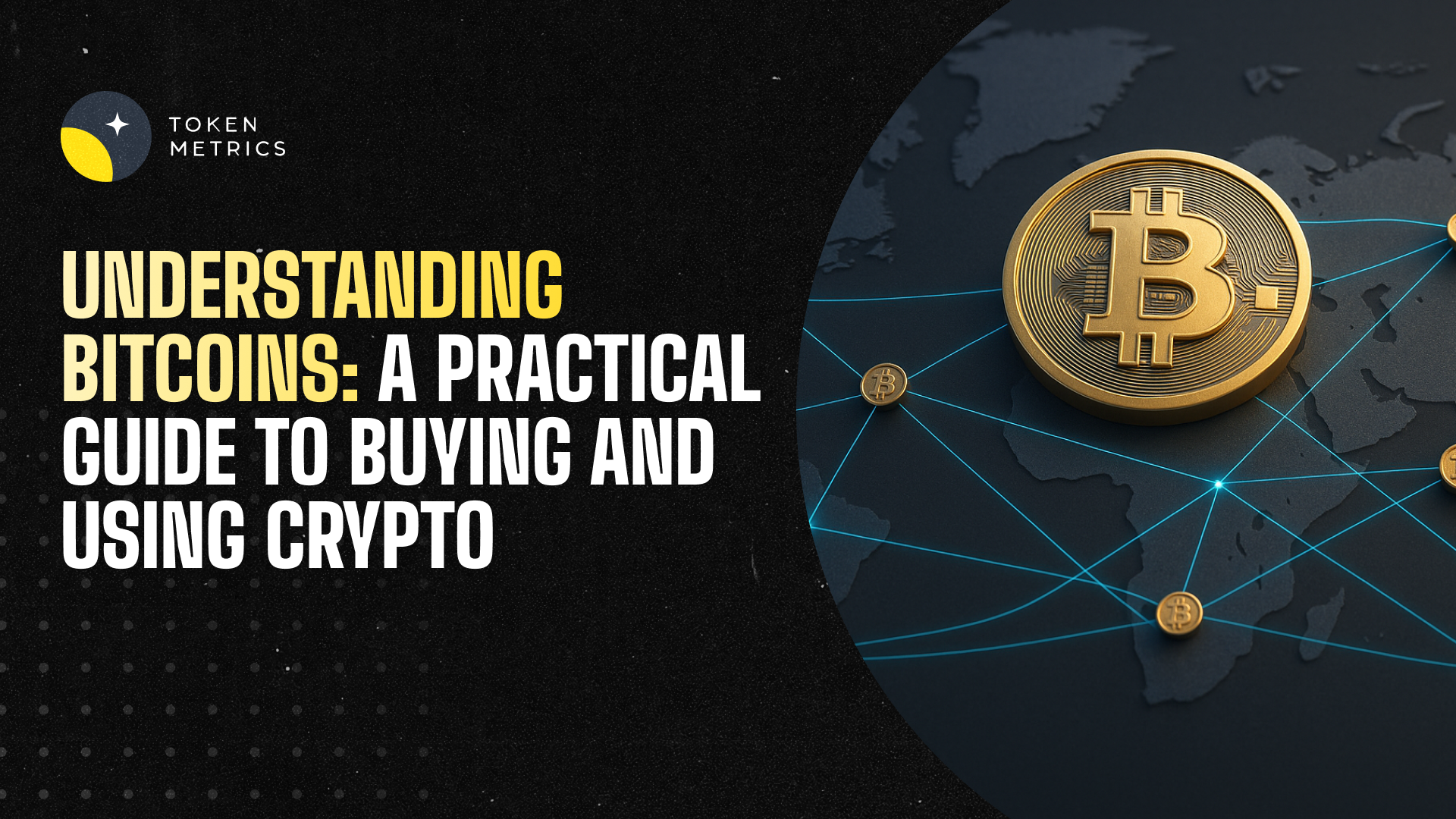
%201.svg)
%201.svg)
Bitcoins represent a revolutionary form of virtual currency that operates without reliance on any central authority or trusted third party. Introduced in 2009 by the enigmatic Satoshi Nakamoto, bitcoins were designed as a decentralized digital currency and cryptocurrency aimed at enabling money and payment transactions directly between peers. Bitcoin is the first decentralized cryptocurrency, setting the stage for a new era in digital finance. This is made possible through the innovative use of blockchain technology, a distributed ledger that records bitcoin transactions securely and transparently. The bitcoin network itself is maintained by a peer-to-peer system of computers, each verifying and broadcasting transactions to ensure the integrity and continuity of the ledger. This decentralized approach eliminates the need for financial institutions or banks to act as intermediaries, making bitcoins a unique asset in the realm of digital currencies. According to the European Central Bank, the decentralization of money offered by bitcoin has roots in the Austrian school of economics.

The story of bitcoins began in August 2008 with the registration of the domain bitcoin.org, signaling the start of a new era in digital money. Shortly thereafter, on January 3, 2009, Satoshi Nakamoto mined the first bitcoin block, known as Block 0 or the genesis block, marking the inception of the bitcoin blockchain. Bitcoin's use as a currency began in 2009 with the release of its open-source implementation, allowing users to participate in this decentralized system. Bitcoin was introduced in response to the global financial crisis to restore trust in transactions outside of traditional systems. Bitcoin started gaining traction in 2010, highlighted by the first commercial transaction where bitcoins were used to purchase goods. Since then, bitcoin prices have experienced significant volatility, with sharp rises and falls reflecting market sentiment, adoption rates, and regulatory developments. Despite its fluctuations, bitcoin has established itself as a pioneering digital currency and a key player in the broader ecosystem of cryptocurrencies.
At its core, bitcoin is built on a decentralized system that leverages cryptographic techniques to secure transactions and maintain trust without a central authority. The blockchain serves as a chronological chain of blocks, each block containing data stored in a way that includes a hash of the previous block. Everyone on the Bitcoin network has access to an independent copy of the blockchain for transaction verification, ensuring transparency and trust. The blockchain is implemented as an ordered list of blocks, where each block contains a hash of the previous block. This linkage ensures the integrity and immutability of the blockchain, as any alteration to previous blocks would be immediately apparent. Miners play a crucial role in this system by using computational power to solve complex mathematical problems that verify bitcoin transactions. Once validated, these transactions are grouped into new blocks and added to the bitcoin blockchain. An interesting feature of bitcoins is their divisibility; each bitcoin can be broken down into eight decimal places, with the smallest unit known as a satoshi, allowing for microtransactions and flexible usage.

For those interested in entering the world of bitcoins, purchasing them typically involves using cryptocurrency exchanges where bitcoin can be bought using fiat currencies such as the US dollar. To buy bitcoin, users must first create a bitcoin address, which acts as a digital wallet for storing and sending bitcoins. Once an account is funded on an exchange, users can execute buy bitcoin orders and begin accumulating this digital asset. As of 2023, River Financial estimated that bitcoin had around 81.7 million users globally. As of 2021, Bitcoin is only recognized as legal tender in El Salvador, showcasing its limited but significant adoption as a national currency. Bitcoins are not only an investment but also a medium of exchange accepted by various merchants and businesses for payments. Additionally, users can sell bitcoin on exchanges or use it for donations and other financial services, highlighting its growing utility as a form of money in the digital age.

Regulating bitcoin presents unique challenges due to its decentralized nature and absence of a central bank or authority. Governments and financial institutions worldwide are still grappling with how best to regulate bitcoin and other digital currencies. While some countries have outright banned bitcoin, others have taken steps to implement frameworks that govern its use, aiming to protect consumers and prevent illicit activities. Legal frameworks for Bitcoin vary significantly across jurisdictions, complicating investment decisions. The regulatory environment remains fluid, with ongoing debates about legal tender status, taxation, and compliance requirements. Understanding these evolving regulations is essential for users and businesses to navigate the legal landscape surrounding bitcoins safely and effectively.
Investing in bitcoins offers both opportunities and risks that potential investors must carefully consider. The market for bitcoins is known for its high fees and significant volatility in bitcoin prices, which can lead to rapid gains or losses. Some investors liken bitcoin to gold, viewing it as a digital store of value and a hedge against inflation and currency devaluation. Investment in bitcoins can be conducted through cryptocurrency exchanges or specialized investment funds that provide exposure to this asset. However, thorough research and a solid understanding of the market dynamics are crucial before committing funds, as bitcoin lacks intrinsic value and is subject to speculative bubbles.

Bitcoin transactions are secured through advanced cryptographic techniques that verify and protect the integrity of each payment made on the network. Despite this robust security at the protocol level, bitcoin exchanges and wallets remain vulnerable to hacking and other cyber threats. Users must adopt stringent security measures such as using strong passwords, enabling two-factor authentication, and safeguarding private keys to protect their bitcoins. The decentralized nature of the bitcoin network, combined with the use of private keys, also provides a certain degree of privacy and anonymity, distinguishing it from traditional financial systems that rely on trusted third parties.
Bitcoin mining is the fundamental process through which new transactions are verified and new blocks are added to the blockchain. Miners employ significant computational power to solve complex mathematical puzzles, a process that requires substantial energy consumption and specialized hardware. A new block in the blockchain is created approximately every 10 minutes for transaction processing, ensuring a steady and predictable flow of new blocks. This mining activity not only secures the network but also enables the creation of new bitcoins, rewarded to miners as a block reward. The bitcoin network operates on a consensus mechanism, ensuring that all nodes agree on the blockchain’s current state, maintaining data consistency across the peer-to-peer network. Many miners join mining pools to combine their computational resources, increasing their chances of successfully mining new blocks and earning rewards.
Despite its innovative design, bitcoin faces several challenges that impact its scalability and adoption. The bitcoin network can experience slow transaction times, often taking up to 10 minutes to confirm payments, which can be a drawback for everyday use. High fees during periods of network congestion further complicate its practicality for small transactions. Bitcoin is rarely used in regular transactions due to high costs, price volatility, and transaction times, limiting its utility as a day-to-day currency. Additionally, bitcoin’s decentralized structure complicates regulatory oversight and governance. Concerns also arise from the use of bitcoins in illicit activities such as money laundering and terrorist financing, prompting calls for enhanced monitoring and regulation. These limitations highlight the need for ongoing development and dialogue to address bitcoin’s shortcomings.
Investing and using bitcoins come with inherent risks that must be acknowledged. The value of bitcoins can fluctuate dramatically, sometimes by thousands of dollars within short periods, exposing investors to potential significant losses. The absence of intrinsic value and the speculative nature of the market raise concerns about the possibility of a bitcoin bubble. Users should mitigate these risks by diversifying their investments and employing secure wallets to protect their funds. Awareness of market volatility and prudent management strategies are essential for anyone engaging with bitcoins as an asset or means of payment.
To maximize benefits and minimize risks, bitcoin users should prioritize education about the technology, market, and associated risks. Using secure wallets and reputable exchanges is fundamental, along with enabling two-factor authentication to enhance account security. Staying informed about the regulatory environment and compliance requirements helps users avoid legal pitfalls. Regularly updating bitcoin software and employing strong passwords further safeguard against security breaches. Adhering to these best practices ensures a safer and more reliable experience when buying, selling, or transacting with bitcoins.
Bitcoin is a complex and rapidly evolving digital currency that has transformed the financial landscape by introducing a decentralized alternative to traditional money. Understanding the fundamentals of bitcoins, from their blockchain technology to their market dynamics and regulatory challenges, is crucial for users, investors, and policymakers alike. While the future of bitcoins and other cryptocurrencies remains uncertain, their growing adoption underscores their potential to reshape how value is exchanged globally. Staying informed and adaptable will be key as bitcoins continue to influence the future of money, payments, and investment.

%201.svg)
%201.svg)
Digital assets, such as bitcoin and other cryptocurrencies, represent a relatively new and distinct asset class characterized by high speculation and substantial risk. Unlike traditional investments, digital currencies operate in a decentralized manner, meaning they are not controlled by central banks or governments. This decentralization contributes to their unique valuation dynamics, which are heavily influenced by investor sentiment and real-time market data rather than traditional economic indicators. However, the cryptocurrency market is largely unregulated, making it susceptible to fraud and manipulation.
Investing in digital currencies requires a solid understanding of the regulatory environment, as agencies like the Securities and Exchange Commission (SEC) continue to shape the landscape with evolving rules and approvals. For example, the SEC has authorized bitcoin ETFs, which have made it easier for investors to gain exposure to the crypto market without directly holding the currency. In 2024, the SEC approved the trading of spot bitcoin and ether exchange-traded funds (ETFs). The SEC's historical relationship with the cryptocurrency market has been skeptical due to concerns about market volatility and investor protections. Despite these advances, it remains crucial for investors to seek personalized investment advice and carefully assess their risk tolerance before venturing into this highly speculative space.
Bitcoin is a pioneering digital currency that leverages blockchain technology and sophisticated computer code to secure transactions and regulate the creation of new units. This technological foundation makes bitcoin a highly volatile asset, with prices that can fluctuate dramatically over short periods. Bitcoin's price has fluctuated significantly since its inception in 2009. The value of bitcoin is primarily determined by what investors are willing to pay, which means its price is subject to rapid changes driven by market sentiment and speculative trading.

One of bitcoin’s defining features is its limited supply, capped at 21 million coins. This scarcity can drive its price higher, contributing to the potential for significant returns. Bitcoin historically has offered the potential for high returns. However, the limited supply also intensifies volatility, as shifts in demand can cause sharp price swings. Unlike traditional currencies or commodities such as gold, bitcoin is not backed by any physical asset or government guarantee, making its intrinsic value difficult to ascertain. Consequently, investing in bitcoin is considered a high-risk endeavor that demands careful evaluation.
For investors interested in gaining exposure to bitcoin without directly purchasing or trading the currency, bitcoin ETFs present a viable alternative. These financial products allow investors to participate in the crypto market through regulated exchange-traded funds, potentially reducing some of the risks associated with direct ownership. The introduction of bitcoin ETFs has contributed to greater acceptance of cryptocurrencies among regulators and institutional investors. Futures-based bitcoin ETFs must regularly 'roll' their holdings, potentially underperforming compared to spot bitcoin ETFs. However, it remains essential to understand the fees involved in trading and transactions, as these can impact overall returns.
Diversification remains a cornerstone of sound investment strategies. Incorporating index funds and other traditional assets alongside digital currencies can help balance a portfolio and mitigate risk. While digital assets offer the allure of high returns, they also come with heightened volatility and uncertainty. Crypto exchanges lack basic consumer protections found in traditional financial products. Consulting a financial planner or investment advisor can provide personalized investment advice tailored to an individual’s financial goals, risk tolerance, and overall portfolio allocation.
Investing in bitcoin and other cryptocurrencies involves substantial risks, including the possibility of significant financial losses. The regulatory environment surrounding digital assets is still evolving, and changes in laws or enforcement policies by bodies such as the Securities and Exchange Commission can dramatically affect market valuations. Furthermore, the lack of central bank oversight means that digital currencies are more exposed to market manipulation and extreme price swings. Transactions involving Bitcoin are irreversible, which can lead to significant loss if credentials are forgotten. Investors should consider only investing money in Bitcoin that they are comfortable losing.
Despite these risks, the potential rewards of investing in bitcoin can be compelling. Its limited supply and increasing adoption have made it attractive to some investors seeking alternatives to traditional assets. Nevertheless, it is vital to weigh these benefits against the inherent risks and to consider other investment options that may better align with one’s financial objectives and risk appetite.

While bitcoin remains the largest and most recognized cryptocurrency by market cap, other digital currencies like ethereum and litecoin offer different features and potential advantages. These alternative cryptocurrencies, often referred to as altcoins, may provide unique use cases or technological innovations that appeal to certain investors. However, similar to bitcoin, they are also subject to high volatility and speculative trading, which can result in both substantial gains and losses.
Investors should carefully evaluate factors such as market capitalization, trading volume, and price volatility when considering other cryptocurrencies. Diversifying across multiple digital assets can help spread risk but requires thorough research and ongoing monitoring of market developments. Staying informed about emerging technologies and regulatory changes is critical in this fast-evolving market.

Determining whether bitcoin is a good investment depends heavily on an individual investor’s financial goals, risk tolerance, and preferred investment strategies. It is essential to conduct comprehensive research and stay updated on market trends, regulatory shifts, and valuation changes to make informed financial decisions. Seeking personalized investment advice from a qualified financial planner can help tailor strategies that align with one’s unique circumstances.
Diversification remains a key principle in building a resilient portfolio. Combining bitcoin and other digital assets with traditional investments such as stocks, bonds, and index funds can help manage risk and improve potential returns. Investments in Bitcoin should only make up a small portion of an investor's portfolio, usually capped at 5% or 10%. Investors should always be prepared for the possibility of significant losses, given the highly volatile nature of cryptocurrencies, and avoid allocating more money than they are willing to lose.

Investing in bitcoin and other digital assets can offer exciting opportunities for high returns but comes with considerable risks and uncertainties. Prospective investors must carefully evaluate the benefits and drawbacks, considering the speculative nature of these assets and the potential for substantial financial losses. The IRS currently treats cryptocurrencies as property, which means cryptocurrency transactions are taxable events. Staying informed about market developments, regulatory changes, and evolving technologies is crucial for making sound investment decisions.
Engaging with financial professionals to obtain personalized investment advice can provide valuable guidance tailored to individual goals and risk profiles. As the cryptocurrency market continues to evolve, maintaining a cautious and well-informed approach is essential. By thoughtfully considering the risks and rewards, investors can make prudent decisions that contribute to achieving their long-term financial objectives while navigating the complexities of digital asset investing.


 Create Your Free Account
Create Your Free Account9450 SW Gemini Dr
PMB 59348
Beaverton, Oregon 97008-7105 US
.svg)




.png)
Token Metrics Media LLC is a regular publication of information, analysis, and commentary focused especially on blockchain technology and business, cryptocurrency, blockchain-based tokens, market trends, and trading strategies.
Token Metrics Media LLC does not provide individually tailored investment advice and does not take a subscriber’s or anyone’s personal circumstances into consideration when discussing investments; nor is Token Metrics Advisers LLC registered as an investment adviser or broker-dealer in any jurisdiction.
Information contained herein is not an offer or solicitation to buy, hold, or sell any security. The Token Metrics team has advised and invested in many blockchain companies. A complete list of their advisory roles and current holdings can be viewed here: https://tokenmetrics.com/disclosures.html/
Token Metrics Media LLC relies on information from various sources believed to be reliable, including clients and third parties, but cannot guarantee the accuracy and completeness of that information. Additionally, Token Metrics Media LLC does not provide tax advice, and investors are encouraged to consult with their personal tax advisors.
All investing involves risk, including the possible loss of money you invest, and past performance does not guarantee future performance. Ratings and price predictions are provided for informational and illustrative purposes, and may not reflect actual future performance.


